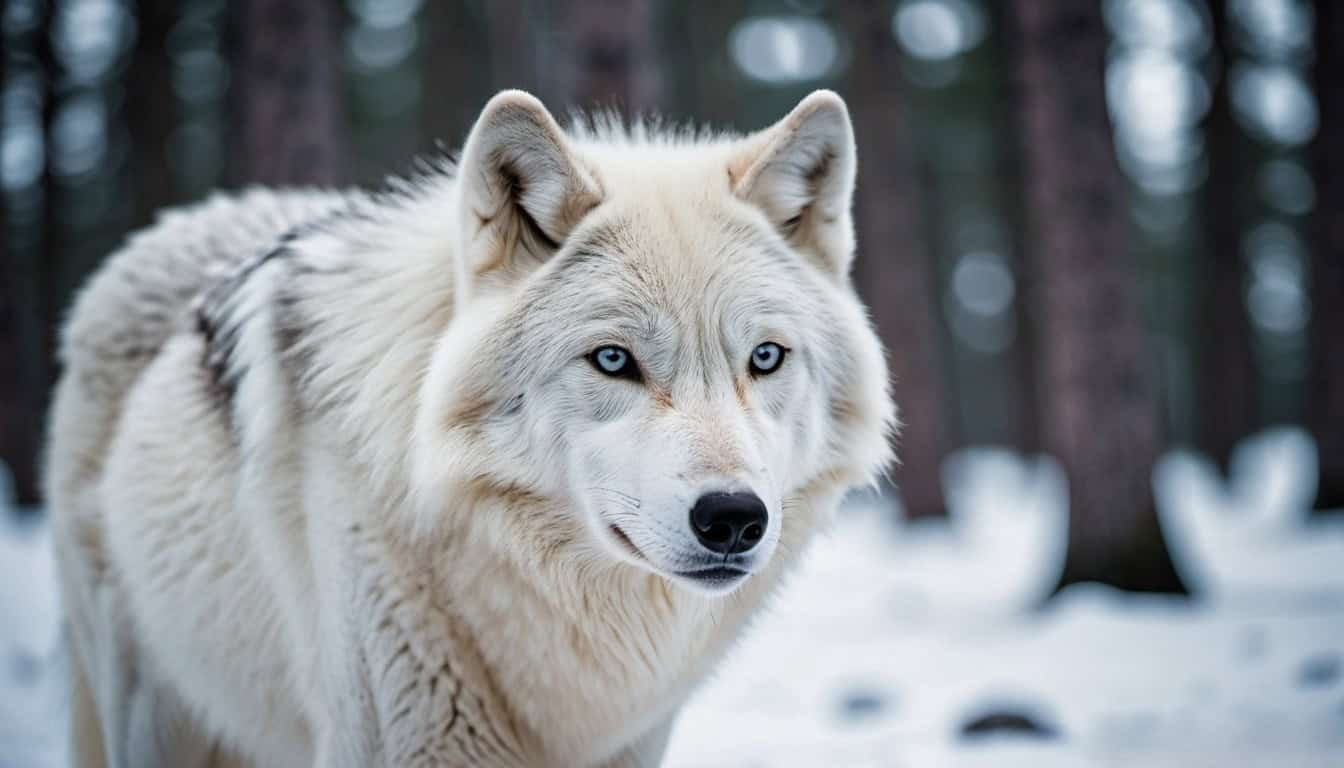Introduction
The Arctic wolf’s spleen is a vital organ with essential roles in the immune and circulatory systems. Understanding its functions provides insights into how these resilient animals survive in their harsh environments
This article explores the anatomy and function of the Arctic wolf’s spleen, its comparative anatomy and unique adaptations, health issues and diagnostic methods, and research insights that could extend to human health studies
Anatomy and Function of the Arctic Wolf’s Spleen
The spleen is a crucial organ for many mammals, including the Arctic wolf. It plays a significant role in both the immune system and the circulatory system
Understanding its structure and functions helps illuminate how the Arctic wolf thrives in its environment
Overview of the Spleen’s Anatomy in Arctic Wolves
The spleen of an Arctic wolf is similar in structure to that of other canines. It is a small, elongated organ located in the abdomen, near the stomach
The spleen is divided into two primary regions, the red pulp and the white pulp:
Red Pulp: This area of the spleen is responsible for filtering the blood. It removes old and damaged red blood cells and recycles iron. The red pulp also acts as a reservoir for blood, which can be released into the circulatory system during times of need, such as during physical exertion or blood loss
White Pulp: This region is part of the immune system. It is rich in white blood cells, particularly lymphocytes, and is crucial for producing an immune response to pathogens
Immune System Contributions
The spleen’s contribution to the Arctic wolf’s immune system is multifaceted. It helps in identifying and responding to pathogens that enter the bloodstream:
Lymphocyte Production: The spleen produces lymphocytes, which are essential for the adaptive immune response. These cells help recognize and remember pathogens, providing immunity against future infections
Phagocytosis: Macrophages in the spleen engulf and digest bacteria, viruses, and other foreign particles. This process helps to clean the blood and prevent infections
Antibody Production: The spleen is involved in the production of antibodies, which are crucial for identifying and neutralizing pathogens. This function is vital for the Arctic wolf, which is exposed to various diseases in its harsh environment
Circulatory System Roles
The spleen also plays a critical role in the circulatory system of the Arctic wolf:
Blood Filtration: The red pulp filters out old and damaged red blood cells, ensuring that the blood remains healthy and functional. This filtration process also helps to recycle iron, which is then used to produce new red blood cells
Blood Reservoir: The spleen acts as a reservoir for blood. During times of physical stress or injury, it can release stored blood into the circulatory system, helping to maintain blood pressure and volume. This function is particularly important for Arctic wolves, which often endure physically demanding activities in their hunt for food
Blood Filtration and Storage
The spleen’s ability to filter and store blood is vital for the Arctic wolf’s survival in its extreme habitat:
Old and Damaged Red Blood Cells: The spleen removes old and damaged red blood cells from circulation. This function helps maintain the efficiency of the circulatory system and ensures that oxygen is effectively transported throughout the body
Iron Recycling: By breaking down old red blood cells, the spleen recycles iron, a critical component for producing new red blood cells. This process helps maintain healthy blood levels, which is essential for the wolf’s endurance and overall health
Emergency Blood Supply: The spleen’s role as a blood reservoir allows it to release additional blood when the wolf needs it most, such as during periods of high activity or after an injury. This capability can be life-saving, ensuring the wolf remains active and capable even under stressful conditions
Comparative Anatomy and Adaptations
Understanding the comparative anatomy and unique adaptations of the Arctic wolf’s spleen provides deeper insights into how these animals thrive in extreme environments
By comparing the spleen of Arctic wolves with those of other mammals, especially other canines, and examining specific adaptations, we can appreciate the evolutionary advantages that support their survival
Differences from Other Mammals and Canines
The spleen of the Arctic wolf shares common features with other mammals, particularly canines, but also has distinct characteristics that set it apart:
Size and Shape: While the overall structure of the spleen is similar across mammals, the size and shape can vary. In Arctic wolves, the spleen tends to be more elongated compared to some other canines. This elongation may be an adaptation to maximize the organ’s efficiency in filtering blood and storing blood cells
Blood Reservoir Capacity: The blood reservoir capacity of the Arctic wolf’s spleen is particularly notable
This adaptation is critical for survival in the harsh Arctic environment where sudden bursts of physical activity, such as chasing prey or escaping predators, are common. The ability to store and rapidly release blood ensures that the wolf can maintain stamina and recover quickly from exertion
Immune Functionality: While the immune functions of the spleen are consistent across mammals, Arctic wolves have a heightened immune response. This enhanced functionality is likely an adaptation to their environment, where exposure to diseases and parasites can be more frequent due to their carnivorous diet and interaction with other wildlife
Adaptations for Cold Environments
The Arctic wolf’s spleen has evolved specific adaptations that enable it to function effectively in extremely cold environments:
Enhanced Blood Filtration: In cold climates, maintaining efficient blood circulation is crucial
The Arctic wolf’s spleen has adapted to filter blood more effectively, ensuring that the circulatory system functions optimally even in low temperatures. This adaptation helps in preventing blood thickening and clots that can be more likely in freezing conditions
Temperature Regulation: The spleen’s ability to store and release blood also plays a role in temperature regulation. By controlling blood flow, the spleen helps maintain core body temperature, ensuring that vital organs receive a consistent supply of warm blood, which is critical for survival in sub-zero temperatures
Immune Response Modulation: The Arctic wolf’s spleen has adapted to modulate immune responses efficiently. In cold environments, the risk of infection can be higher due to the harsh living conditions and the scarcity of food
The spleen’s ability to quickly respond to pathogens ensures that the wolf can fend off diseases and maintain health despite these challenges
Unique Features Compared to Other Canines
The Arctic wolf’s spleen exhibits unique features that distinguish it from other canines, reflecting its specialized adaptations for survival in Arctic regions:
Increased White Pulp Density: The white pulp of the spleen, responsible for immune responses, is denser in Arctic wolves compared to other canines. This increased density means a higher concentration of immune cells, which enhances the wolf’s ability to fight infections and recover from illnesses
Robust Red Pulp Functionality: The red pulp in Arctic wolves is more efficient at recycling iron and removing damaged blood cells. This robust functionality is essential for maintaining high levels of red blood cells, which is crucial for transporting oxygen in the thin, cold air of the Arctic
Adaptive Hematopoiesis: The process of hematopoiesis, or the formation of blood cells, is adapted in Arctic wolves to respond quickly to changes in the environment. This adaptation allows the spleen to produce more blood cells during times of high activity or stress, supporting the wolf’s endurance and resilience
Health, Diseases, and Diagnostics
Understanding the health and potential diseases of the Arctic wolf’s spleen, along with the diagnostic methods used to identify spleen issues, is critical for both conservation efforts and veterinary care
This section delves into common spleen diseases, diagnostic approaches, and the overall impact of spleen health on the Arctic wolf’s wellbeing
Common Diseases and Conditions
The spleen, being a crucial organ in the Arctic wolf’s immune and circulatory systems, can be affected by several diseases and conditions:
Splenomegaly: This condition refers to the enlargement of the spleen, which can be caused by infections, inflammatory diseases, or cancers such as lymphoma. Splenomegaly can impair the spleen’s ability to filter blood and produce immune responses
Hemangiosarcoma: A type of cancer that originates in the blood vessels and often affects the spleen. Hemangiosarcoma is particularly aggressive and can lead to internal bleeding and splenic rupture, which are life-threatening if not treated promptly
Infections: The spleen can become infected due to bacterial, viral, or parasitic agents. Infections can lead to splenitis (inflammation of the spleen), impacting its function and leading to systemic health issues
Autoimmune Diseases: In some cases, the spleen can be involved in autoimmune diseases where the body’s immune system mistakenly attacks its own cells. This can cause significant damage to the spleen’s tissue and function
Diagnostic Methods
Diagnosing spleen-related issues in Arctic wolves involves several veterinary techniques and tools:
Physical Examination: Veterinarians often start with a physical examination, palpating the abdominal area to check for splenomegaly or pain that might indicate spleen issues
Ultrasound: This non-invasive imaging technique is commonly used to visualize the spleen and detect abnormalities such as tumors, cysts, or enlargement. Ultrasound is particularly useful for diagnosing conditions like hemangiosarcoma
Blood Tests: Blood tests can reveal abnormalities in red and white blood cell counts, indicating potential spleen dysfunction. High white blood cell counts might suggest an infection or inflammatory condition, while low counts can indicate spleen damage
Biopsy: In some cases, a biopsy may be necessary to diagnose specific conditions like cancers. This involves taking a small tissue sample from the spleen for microscopic examination
X-rays and CT Scans: These imaging methods can provide detailed pictures of the spleen and surrounding organs, helping to identify structural changes or masses
Impact on Overall Health
The health of the spleen significantly affects the overall health and survival of the Arctic wolf:
Immune System Efficiency: A healthy spleen is essential for a robust immune response. It helps in producing and regulating lymphocytes and antibodies, which are critical for fighting off infections and diseases. Spleen dysfunction can lead to increased susceptibility to infections and slower recovery from illnesses
Blood Filtration and Storage: The spleen’s role in filtering blood and storing red blood cells ensures that the wolf can maintain adequate blood volume and quality. Issues with the spleen can lead to anemia, reduced oxygen transport, and overall weakness
Nutrient Recycling: The spleen’s ability to recycle iron and other nutrients from old red blood cells is vital for the wolf’s health. Impairment in this function can lead to deficiencies that affect energy levels, growth, and overall vitality
Research and Insights
Research into the spleen of Arctic wolves not only enhances our understanding of their biology and physiology but also provides insights that can be applied to broader scientific and medical fields
This section explores how researchers study the spleen in wild Arctic wolves, and the potential implications for human spleen research
Studying the Spleen in Wild Arctic Wolves
Studying the spleen of wild Arctic wolves involves various methods and techniques that help scientists gather comprehensive data while ensuring minimal disruption to the animals:
Field Observations: Researchers conduct field observations to understand the wolves’ behavior, health, and overall condition. These observations provide contextual data that can help correlate spleen health with environmental factors, diet, and activity levels
Non-invasive Techniques: Techniques such as fecal sample analysis and remote monitoring are employed to gather data without capturing or harming the wolves. These methods can provide insights into the health and functioning of the spleen indirectly, such as through hormone levels and indicators of stress or disease
Capture and Release Studies: In some cases, wolves are temporarily captured for more detailed examinations, including ultrasound imaging and blood tests. This allows for direct assessment of spleen size, structure, and function. After examination, the wolves are released back into the wild with minimal stress and harm
Telemetry and Tracking: GPS collars and other tracking devices help researchers monitor the wolves’ movements, health, and interactions over time. Data collected from these devices can be correlated with health assessments to understand the impact of environmental factors on spleen function
Autopsy and Tissue Analysis: Unfortunately, when wolves die in the wild or are found deceased, autopsies and tissue analysis can provide invaluable data on spleen health, disease prevalence, and the impact of various factors on spleen function. Tissue samples are examined histologically to identify any pathological changes or abnormalities
Implications for Human Spleen Research
Research on the spleen of Arctic wolves can offer valuable insights that are relevant to human medicine and biology:
Comparative Immunology: By studying the immune functions of the Arctic wolf’s spleen, researchers can gain a better understanding of immune responses in extreme environments. This knowledge can inform the development of treatments and interventions for immune system disorders in humans
Adaptation Mechanisms: The adaptations of the Arctic wolf’s spleen to cold environments can shed light on how human organs might adapt to extreme conditions, such as high altitudes or cold climates. This research can inform medical strategies for people living in or traveling to such environments
Disease Resistance: Understanding how the Arctic wolf’s spleen responds to infections and diseases can provide clues for enhancing disease resistance in humans. This includes insights into autoimmune diseases, infections, and cancer, leading to potential advancements in preventative and therapeutic measures
Stress and Health Correlations: The correlation between environmental stressors and spleen health in Arctic wolves can help researchers understand how stress impacts human spleen function and overall health. This can lead to better management of stress-related health issues
Veterinary Medicine: Insights gained from studying Arctic wolves can also improve veterinary practices for domestic dogs and other canines. This can enhance the diagnosis and treatment of spleen-related conditions, benefiting both pets and their owners
Conclusion
Understanding the function of the Arctic wolf’s spleen reveals its crucial role in the animal’s survival, especially in extreme environments
This comprehensive exploration covered various aspects of the spleen, including its anatomy, functions, and health issues, along with comparative anatomy and unique adaptations that support the Arctic wolf’s resilience
We also delved into the research methods used to study the spleen in wild Arctic wolves and the broader implications these studies have for human health and medical research
The spleen in Arctic wolves serves multiple functions, from filtering blood and recycling iron to acting as a blood reservoir and supporting the immune system. These functions are vital for maintaining the wolf’s overall health and ability to withstand the harsh Arctic conditions
Unique adaptations, such as enhanced blood filtration and immune response modulation, set the Arctic wolf apart from other canines and mammals
Health issues like splenomegaly, hemangiosarcoma, infections, and autoimmune diseases can affect the spleen, impacting the wolf’s health significantly. Diagnostic methods, including physical examinations, ultrasound, blood tests, and biopsies, help veterinarians and researchers identify and treat these conditions effectively
Research into the Arctic wolf’s spleen not only enhances our understanding of this remarkable animal but also offers valuable insights into human medicine
Comparative immunology, adaptation mechanisms, disease resistance, and stress-health correlations are just a few areas where findings from Arctic wolf studies can inform human health practices
In conclusion, the spleen is an essential organ that plays a critical role in the Arctic wolf’s survival. Through continued research and conservation efforts, we can ensure the health and wellbeing of these magnificent creatures while also gaining knowledge that benefits broader scientific and medical fields










